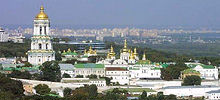Kievtown.net
Kiev travel guide

Kievtown.net Kiev travel guide |
 |
|||
SIGHTS: Monument to Bogdan Khmelnitsky
|
Address: St. Sofia Square How to get: go to the metro station Maydan Nezalezhnosti, then go downwards 2 blocks along Sofia street; or go to the metro station Golden Gate and pass downwards along Vladimirskaya street to St. Sofia square
Monument to Bogdan Khmelnitsky is most known city monument, an original symbol of Kiev. It is put up in honour of hetman Bogdan Khmelnitsky, who went down in history of Ukraine as an outstanding commander, statesman, headed the revolt of Ukrainian people against Rech Pospolitaya rule. Bogdan Khmelnitsky is also known for Pereyaclavskaya Rada that made Moskovia and Ukraine allies. In the middle of 19 century Ukrainian art workers decided to put up a monument to Bogdan Khmelnitsky in Kiev or Pereyaslav. There is no unambiguous answer , who was first with this idea. Authorship is divided between two professors: Michael Maksimovich and Nikolay Kostomarov. Realisation of the plan became possible thanks to Michael Juzefovich, a professor also, a head of Kiev commission of study of early texts. Project of the monument had to be developed by the famous painter and sculptor Michael Mikeshin. First project of the monument was performed with grandiose scope. On a granite pedestal, resembling a barrow, the hetman sad on a prancing horse. Under horse’s hoofs it was supposed to depict a spread body of priest-Jesuit covered with torn Polish banner and links of torn chains laying nearby. Figures of Polish gentlemen (Pol. - shlyahtich) and Jew-lessee fell from the barrow, knocked down by galloping horse. 4 more figures had to be situated in front of barrow – blind kobza player and his listeners: Byelorussian, Little Russian, Great Rusian and Chervony Russian. Bas-reliefs had to represent the episodes of Batle under Zbarazh and Entrance of Hmelnitsky’s army to Kiev. Funds for the monument were proposed to be raised by charitable collection, but donations came badly. Political motives and lack of funds became the reason for much more modest composition. Trampled Polish banner and Antisemitic subject area were rejected, figures of kobza player and his listeners, and bas-reliefs also disappeared. Sea department donated 1600 poods (25,6 t.) of old ship copper for the monument building. In 1877 a plaster model was made at last, and in 1879, in St.-Petersburg, with the assistance of sculptors Piy Adamovich Velionsky and Artemiy Lavrentevich Ober, the composition was casted in metal at Berd’s founding-mechanical factory.
The place for the monument to hetman Bogdan Khmelnitsky was assigned after long disputes – it was solved that it would be St. Sofia square. But unexpectedly a ban was imposed by Petersburg. The matter was that the monument placed at Sofia square, would be settled down between an altar wall of Kiev Sofia cathedral and building of St. Michael’s cathedral. The statue was oriented so that the hetman mace was aimed at Poland with threat. That means that Bogdan Khmelnitsky’s horse was turned to an altar wall of Sofia cathedral by its tail, and exactly it was contemplated by numerous pilgrims, gathering in cathedral, instead of Christian relics. Besides, the cathedral passed out of sight from St. Michael’s monastery and Kreschatik. This fact aroused indignation of Kiev clergy, and they filed a grievance to Synod. Eight years the finished monument to Bogdan Khmelnitsky was standing in the yard of Old Kiev police station because there was no money for building of the granite pedestal. Kievers joked that the hetman was arrested because " arrived without passport". At last, in 1886 12000 roubles were allocated from the city treasure, and Kiev fortress justice gave for monument 30 cubic sazhens of granite that remained from building of Chain (Zepnoy) bridge support, after that architect Vladimir Nikolaev designed and constructed the monument pedestal. Kiev architect worked free of charge and spent the money, that were due to him for his work, for a fence with lanterns round the monument. The sculptural composition was swung around, in order that not to offense believers’ feeling, and the mace began to threaten sooner towards Sweden, than towards Poland. Despite ordinary opinion, the mace was never directed towards Moscow. Only inscriptions on the pedestal: "We want the tsar east, orthodox" and "For Bogdan Khmelnitsky single indivisible Russia" told about Russia participation. In 1919 and 1924 these inscriptions were replaced for "Bogdan Khmelnitskiy. 1888" that remained till our days. On July, 11th, 1888, during the celebrating in Kiev of the 900 anniversary of Russia christening, monument to Bogdan Khmelnitsky was finally installed and sanctified. Monument to Bogdan Khmelnitsky impresses by its dynamism. As if the horseman reined in the horse at full tilt to appeal to people. Portrait is quite similar to the prototype, and clothes details are also reproduced accurately. The pedestal of the sculptural composition is rather low, besides, it is accessible to all-round visibility and gives an opportunity to take a good look at all composition details, which are worked out very carefully.
|
Àâèàáèëåòû äåøåâî
buruki.ru - äåøåâûå àâèàáèëåòû |
|||||